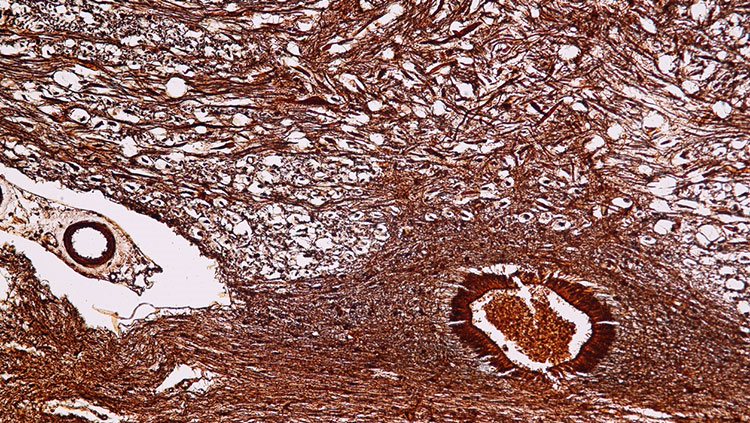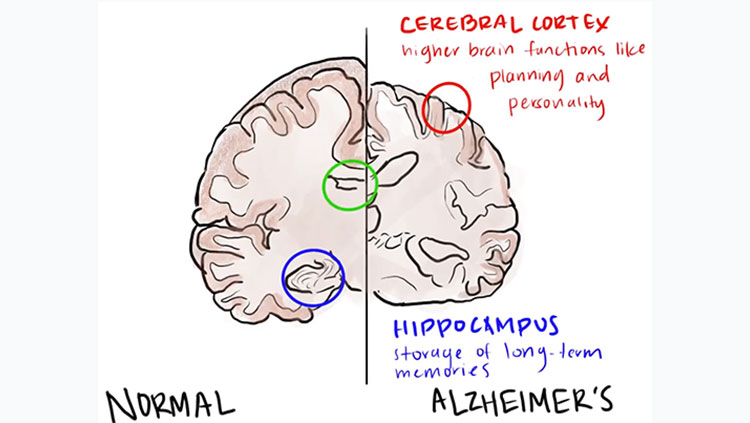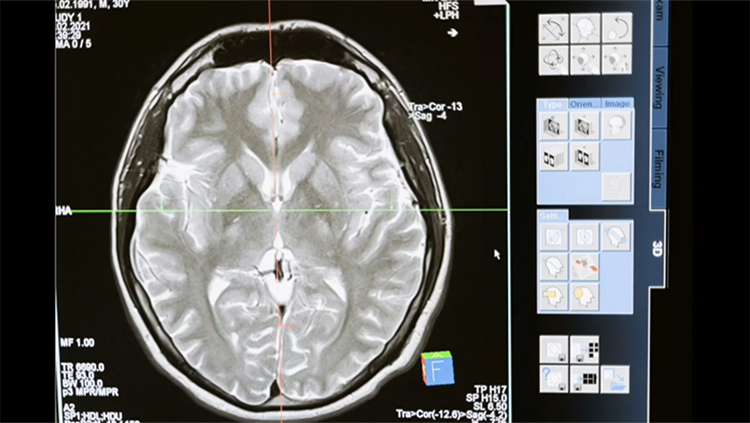Making Sense of Parkinson’s Disease
- Reviewed10 Apr 2023
- Author Clinton Parks
- Source BrainFacts/SfN

Parkinson’s disease is the second most common neurodegenerative disorder in humans. Like Alzheimer’s disease, its incidence increases with age, with the average onset around age 60. About 5 million people in the world’s 10 most populous countries have Parkinson’s, and its frequency is expected to double by 2030. With 50,000 to 60,000 cases diagnosed annually in the U.S., the actual figures may be much higher — especially since early symptoms can be mistaken for normal aging and thus are not reported.
From 2000 to 2013, the age-adjusted death rates for those with Parkinson’s disease increased in the U.S. from 8.8 to 11.0 per 100,000 for males and from 3.9 to 4.8 per 100,000 for females. For reasons not yet fully understood, the disease is more prevalent in males than in females. About 5% to 10% of cases are “early-onset,” occurring before age 50. Rarer still, patients with “juvenile Parkinsonism” may develop symptoms before age 20.
Estimates of the prevalence, or overall number, of Parkinson’s patients vary widely, so incidence — the occurrence of new cases within a given time period (for example, per year) — is a better index for this disease. There is a higher incidence of Parkinson’s in developed countries, but the reason is unknown. Although, increased risk of the disease has also been reported in areas with increased pesticide use.
Symptoms
At first, Parkinson’s is characterized by motor problems: slow movement; muscular rigidity; poor coordination and instability; and shaking in hands, arms, legs, jaw, and face while at rest. As the disease progresses, the shaking, known as resting tremor, may worsen and interfere with walking, talking, and other simple tasks. Cognitive decline often presents at later stages. Some people develop depression and other emotional changes, difficulty swallowing and chewing, skin problems, constipation, or urinary problems, and sleeping problems. However, the rate and intensity of Parkinson’s progression vary. Some people become severely disabled, while others have only minor motor disruptions.
Pathology and Causes
Parkinson’s is a motor system disorder caused by the loss of dopamine-producing cells neurons in the substantia nigra — a midbrain structure that is considered part of the basal ganglia. This brain region affects movement, reward, and addiction. At the cellular level, the death of neurons likely arises as a result of damage to mitochondrial respiration.
Some early-onset cases are linked to mutations in the PARK2 (or PRKN) gene, which codes for the protein “parkin.” Most types of Parkinson’s are caused by a combination of genetics and environment, but an estimated 15% to 25% of people with adult-onset Parkinson’s have a known relative with the disease. Genes like alpha-synuclein (SNCA), repeat kinase 2 (LRRK-2), and glucocerebrosidase (GBA) also point to the importance of genetics as a causal factor.
While Parkinson’s and Lewy body dementia are sometimes considered different disorders, Lewy bodies, accumulations of proteins in neuron bodies, have been implicated in both diseases. Lewy bodies are mainly composed of the protein alpha-synuclein entangled with other proteins, including neurofilament, ubiquitin, alpha B crystallin, and probably tau protein in neurofibrillary tangles. The Lewy body protein, alpha-synuclein, is involved in dopamine transport in the nervous system.
There is no definitive test for Parkinson’s. So without accepted biomarkers, diagnosis is based on medical history and neurological tests that can include brain scans. Accurate diagnosis can be difficult, because some non-Parkinson’s conditions display similar symptoms. In the future, mitochondrial molecules could be a potential source of a Parkinson’s biomarker.
Research
Scientists can treat mice with the chemical MPTP (1-methyl-4- phenyl-1,2,3,6-tetrahydropyridine) to create an animal model that can provide further insight into Parkinson’s. In the body, MPTP metabolizes into the neurotoxin MPP+ (1-methyl-4-phen- ylpyridinium), which causes a Parkinson’s-like loss of cells in the substantia nigra and cognitive deficits. However, MPTP does not perfectly mimic the symptoms of human Parkinson’s disease, including the motor deficits.
Research on using stem cells to replace damaged dopamine neurons in Parkinson’s patients has shown promise. There are two types of stem cells: the more flexible (and controversial) fetal tissue and induced pluripotent stem (iPS) cells, which are specialized adult (often blood or skin) cells that have been repurposed into a generalized embryonic state. There have been successful lab studies using iPS cells, and positive to mixed results in clinical studies with the fetal stem cells. A 2017 Kyoto University study transferred human iPS cells into the brains of monkeys treated with MPTP. Two years after this transplantation, the treated monkeys were shown to have healthy DA neuron integration, growth, and even functioning in the striatum.
Treatments
Treatment with levodopa (L-Dopa) temporarily relieves Parkinson’s motor symptoms but does not slow disease progression. The long-term use of L-Dopa can induce dyskinesia — abnormal and uncontrolled involuntary movements. Strategies for treating Parkinson’s include gene therapy and targeting specific cellular molecules.
A surgical procedure called deep brain stimulation (DBS) is increasingly used to treat Parkinson’s patients whose symptoms, including rigidity, tremor, slowed movement, and mobility problems, do not respond adequately to medication. The DBS technique implants a small neurostimulator device — like a pacemaker — that sends electrical impulses that interfere with and block brain signals that cause the motor symptoms of Parkinson’s. Before implanting a neurostimulator into the brain, the neurosurgeon locates where the patient’s symptoms are originating from, using MRI or CT scans. Most often, the problem areas in the brain are the thalamus, the subthalamic nucleus, and a portion of the globus pallidus (part of the basal ganglia). After the imaging, microelectrode recording — which involves a small wire that monitors the activity of nerve cells in the target area — is sometimes used to further localize problem areas in the brain. This approach has proven to be highly successful with a segment of patients.
One treatment still in the research stage is a strategy to break apart Lewy bodies. The idea is to use high hydrostatic pressure to break apart aggregated alpha-synuclein fibril plaques, like those found in Lewy bodies, and return the protein to its properly functioning form. Researchers are exploring Parkinson’s disease prevention through epidemiological studies. Some scientists have found that the disease is less common among coffee drinkers and cigarette smokers. If caffeine and nicotine offer protection, this could reflect some central action that benefits the brain’s dopaminergic systems.
Adapted from the 8th edition of Brain Facts by Clinton Parks.
CONTENT PROVIDED BY
BrainFacts/SfN
References
Alzheimer’s Disease Fact Sheet. (2017). National Institute on Aging. NIH. https://www.nia.nih.gov/health/alzheimers-disease-fact-sheet
Bischof, G. N., Bartenstein, P., Barthel, H., van Berckel, B., Doré, V., van Eimeren, T., Foster, N., Hammes, J., Lammertsma, A. A., Minoshima, S., Rowe, C., Sabri, O., Seibyl, J., Van Laere, K., Vandenberghe, R., Villemagne, V., Yakushev, I., & Drzezga, A. (2021). Toward a Universal Readout for 18F-Labeled Amyloid Tracers: The CAPTAINs Study. Journal of Nuclear Medicine. 62(7), 999–1005. https://doi.org/10.2967/jnumed.120.250290
Borel, F., Gernoux, G., Cardozo, B., Metterville, J. P., Toro Cabrera, G. C., Song, L., Su, Q., Gao, G. P., Elmallah, M. K., Brown, R. H., Jr, & Mueller, C. (2016). Therapeutic rAAVrh10 Mediated SOD1 Silencing in Adult SOD1(G93A) Mice and Nonhuman Primates. Human gene therapy, 27(1), 19–31. https://doi.org/10.1089/hum.2015.122
Chronic Traumatic Encephalopathy (CTE). (n.d.) Related Conditions. Alzheimer’s Association. https://www.alz.org/alzheimers-dementia/what-is-dementia/related_conditions/chronic-traumatic-encephalopathy-(cte)
Cummings, J. L., Morstorf, T. & Zhong, K. (2014). Alzheimer’s disease drug-development pipeline: few candidates, frequent failures. Alz Res Therapy 6, 37. https://doi.org/10.1186/alzrt269
de Oliveira, G., Marques, M., Cruzeiro-Silva, C. et al. Structural basis for the dissociation of α-synuclein fibrils triggered by pressure perturbation of the hydrophobic core. Sci Rep 6, 37990 (2016). https://doi.org/10.1038/srep37990
Dementia. (2017). Fact Sheets. World Health Organization. https://www.who.int/en/news-room/fact-sheets/detail/dementia
Dementia statistics. (2023). Numbers of people with dementia. Alzheimer’s Disease International. https://www.alzint.org/about/dementia-facts-figures/dementia-statistics/
DiSalvo, D. (June 2017). Alzheimer's Affects Twice As Many People As Estimated, And The Numbers Are Climbing. Forbes. https://www.forbes.com/sites/daviddisalvo/2017/06/15/alzheimers-affects-twice-as-many-people-as-estimated-suggests-new-study/?sh=2e7add3d644a
Dorsey, E. R., Constantinescu, R., Thompson, J. P., Biglan, K. M., Holloway, R. G., Kieburtz, K., Marshall, F. J., Ravina, B. M., Schifitto, G., Siderowf, A., Tanner, C. M. (Jan 2007). Projected number of people with Parkinson disease in the most populous nations, 2005 through 2030. Neurology, 68 (5) 384-386; DOI: 10.1212/01.wnl.0000247740.47667.03
Earlier Diagnosis. (n.d.) Research and Progress. Alzheimer’s Association. https://www.alz.org/alzheimers-dementia/research_progress/earlier-diagnosis
Family history of Alzheimer’s may alter metabolic gene that increases risk for disease. (May 2017). Iowa State University of Science and Technology. https://www.news.iastate.edu/news/2017/05/22/alzheimersgene
FDA Approves First Drug to Image Tau Pathology in Patients Being Evaluated for Alzheimer’s Disease. (2020). FDA. https://www.fda.gov/news-events/press-announcements/fda-approves-first-drug-image-tau-pathology-patients-being-evaluated-alzheimers-disease
Fernández, A., Llacuna, L., Fernández-Checa, J. C., & Colell, A. (2009). Mitochondrial cholesterol loading exacerbates amyloid beta peptide-induced inflammation and neurotoxicity. The Journal of neuroscience: the official journal of the Society for Neuroscience, 29(20), 6394–6405. https://doi.org/10.1523/JNEUROSCI.4909-08.2009
Gale, C., & Martyn, C. (2003). Tobacco, coffee, and Parkinson's disease. BMJ (Clinical research ed.), 326(7389), 561–562. https://doi.org/10.1136/bmj.326.7389.561
Grainger, D. (January 2015). Why Too Many Clinical Trials Fail -- And A Simple Solution That Could Increase Returns On Pharma R&D. Forbes. https://www.forbes.com/sites/davidgrainger/2015/01/29/why-too-many-clinical-trials-fail-and-a-simple-solution-that-could-increase-returns-on-pharma-rd/?sh=a8ba6bedb8b3
Goldman, B. (September 2013). Scientists reveal how beta-amyloid may cause Alzheimer's. Stanford Medicine. https://med.stanford.edu/news/all-news/2013/09/scientists-reveal-how-beta-amyloid-may-cause-alzheimers.html
Guerreiro, R., Wojtas, A., Bras, J., Carrasquillo, M., Rogaeva, E., Majounie, E., Cruchaga, C., Sassi, C., Kauwe, J. S., Younkin, S., Hazrati, L., Collinge, J., Pocock, J., Lashley, T., Williams, J., Lambert, J. C., Amouyel, P., Goate, A., Rademakers, R., Morgan, K., … (2013). Alzheimer Genetic Analysis Group. TREM2 variants in Alzheimer's disease. The New England Journal of Medicine, 368(2), 117–127. https://doi.org/10.1056/NEJMoa1211851
He, W., Goodkind, D., Kowal, P. (March 2016). An Aging World: 2015. 5th Edition. United States Census Bureau. https://www.census.gov/newsroom/press-releases/2016/cb16-54.html
Hebert, L. E., Weuve, J., Scherr, P. A., Evans, D. A. (May 2013). Alzheimer disease in the United States (2010–2050) estimated using the 2010 census. Neurology, 80 (19) 1778-1783; DOI:10.1212/WNL.0b013e31828726f5
Henchcliffe, C., & Beal, M. F. (2008). Mitochondrial biology and oxidative stress in Parkinson disease pathogenesis. Nature clinical practice. Neurology, 4(11), 600–609. https://doi.org/10.1038/ncpneuro0924
Heneka, M. T., Carson, M. J., Khoury, J. E., Landreth, G. E., Brosseron, F., et. al. (2015) Neuroinflammation in Alzheimer’s Disease. The Lancet Neurology. 14 (4) 388-405. https://doi.org/10.1016/S1474-4422(15)70016-5.
Jonas E. A. (2014). Impaired import: how huntingtin harms. Nature Neuroscience, 17(6), 747–749. https://doi.org/10.1038/nn.3726
Kiernan, M. C., Vucic, S., Cheah, B. C., Turner, M. R., Eisen, A., Hardiman, O., Burrell, J. R., & Zoing, M. C. (2011). Amyotrophic lateral sclerosis. Lancet (London, England), 377(9769), 942–955. https://doi.org/10.1016/S0140-6736(10)61156-7
Kikuchi, T., Morizane, A., Doi, D. et al. (2017). Human iPS cell-derived dopaminergic neurons function in a primate Parkinson’s disease model. Nature, 548, 592–596. https://doi.org/10.1038/nature23664
Kochanek, K. D., Murphy, S. L., Xu, J., and Tejada-Vera, B. (June 2016). Deaths: Final Data for 2014. National Vital Statistics Reports, 65 (4) 1-122. Centers for Disease Control. https://www.cdc.gov/nchs/data/nvsr/nvsr65/nvsr65_04.pdf
Lees, A. J., Hardy, J., & Revesz, T. (2009). Parkinson's disease. Lancet (London, England), 373(9680), 2055–2066. https://doi.org/10.1016/S0140-6736(09)60492-X
Lemere, C. A. Immunotherapy for Alzheimer’s disease: hoops and hurdles. Mol Neurodegeneration, 8, 36 (2013). https://doi.org/10.1186/1750-1326-8-36
Lue, L. F., Kuo, Y. M., Roher, A. E., Brachova, L., Shen, Y., Sue, L., Beach, T., Kurth, J. H., Rydel, R. E., & Rogers, J. (1999). Soluble amyloid beta peptide concentration as a predictor of synaptic change in Alzheimer's disease. The American journal of pathology, 155(3), 853–862. https://doi.org/10.1016/s0002-9440(10)65184-x
McGinley, L. (January 2023). Alzheimer’s drug that slows cognitive decline gets FDA approval. The Washington Post. https://www.washingtonpost.com/health/2023/01/06/alzheimers-drug-lecanemab-fda-approval/
Monoclonal Antibodies. (February 2023). Cleveland Clinic. https://my.clevelandclinic.org/health/treatments/22246-monoclonal-antibodies
Niemelä, V., Landtblom, A. M., Blennow, K., & Sundblom, J. (2017). Tau or neurofilament light-Which is the more suitable biomarker for Huntington's disease?. PloS one, 12(2), e0172762. https://doi.org/10.1371/journal.pone.0172762
Number of Alzheimer's deaths found to be underreported. (May 2014). National Institute on Aging. NIH. https://www.nia.nih.gov/news/number-alzheimers-deaths-found-be-underreported
Padda IS, Parmar M. Aducanumab. (November 2022). In: StatPearls [Internet]. Treasure Island (FL): StatPearls Publishing; 2022 Jan-. Available from: https://www.ncbi.nlm.nih.gov/books/NBK573062/
Parkinson’s Disease. (n.d.) Harvard Stem Cell Institute. The President and Fellows of Harvard College. https://hsci.harvard.edu/parkinsons-disease-0
Parkinson's Disease: Hope Through Research. (n.d) National Institute of Neurological Disorders and Stroke. NIH. https://www.ninds.nih.gov/health-information/patient-caregiver-education/hope-through-research/parkinsons-disease-hope-through-research
Phase 3 Clinical Trial Targeting Lou Gehrig's Disease Gets $15.9 Million Investment From Stem Cell Agency. (July 2017). California Insititute for Regenerative Medicine. https://www.cirm.ca.gov/about-cirm/newsroom/press-releases/07202017/phase-3-clinical-trial-targeting-lou-gehrigs-disease
Reardon, S. (2023). FDA approves Alzheimer’s drug lecanemab amid safety concerns. Nature. https://www.nature.com/articles/d41586-023-00030-3
Schulte, J., & Littleton, J. T. (2011). The biological function of the Huntingtin protein and its relevance to Huntington's Disease pathology. Current Trends in Neurology, 5, 65–78. https://www.ncbi.nlm.nih.gov/pmc/articles/PMC3237673/
Shugart, J. (July 2017). C9ORF72 Throws a Wrench into DNA Repair Machinery. Alzforum. FBRI, LLC. https://www.alzforum.org/news/research-news/c9orf72-throws-wrench-dna-repair-machinery
Sun, X., Chen, W. D., & Wang, Y. D. (2015). β-Amyloid: the key peptide in the pathogenesis of Alzheimer's disease. Frontiers in Pharmacology, 6, 221. https://doi.org/10.3389/fphar.2015.00221
The Ionis antisense pipeline. (n.d.) Ionis Pharmaceuticals, Inc. https://www.ionispharma.com/ionis-innovation/pipeline/
van Dyck, C. H., Swanson, C. J., Aisen, P., Bateman, R. J., Chen, C., Gee, M., Kanekiyo, M., Li, D., Reyderman, L., Cohen, S., Froelich, L., Katayama, S., Sabbagh, M., Vellas, B., Watson, D., Dhadda, S., Irizarry, M., Kramer, L. D., & Iwatsubo, T. (2023). Lecanemab in Early Alzheimer's Disease. The New England journal of medicine, 388(1), 9–21. https://doi.org/10.1056/NEJMoa2212948
van Rheenen, W., Shatunov, A., Dekker, A. et al. (2016). Genome-wide association analyses identify new risk variants and the genetic architecture of amyotrophic lateral sclerosis. Nat Genet 48, 1043–1048. https://doi.org/10.1038/ng.3622
Xu, J. (September 2015). QuickStats: Age-Adjusted Death Rates for Parkinson Disease — United States, 2000–2013. Morbidity and Mortality Weekly Report. National Vital Statistics System, 64 (36);1034. Mortality public use data files, 2000–2013. Centers for Disease Control and Prevention. https://www.cdc.gov/mmWr/preview/mmwrhtml/mm6436a9.htm
What are the Signs of Alzheimer’s Disease? (2017). National Institute on Aging. NIH. https://www.nia.nih.gov/health/what-are-signs-alzheimers-disease
What is ALS? (n.d.) The ALS Association. https://www.als.org/understanding-als/what-is-als
What to Read Next
Also In Neurodegenerative Disorders
Trending
Popular articles on BrainFacts.org


















